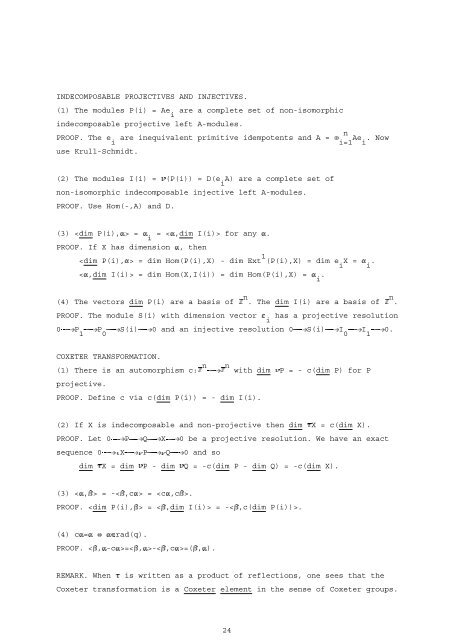Lectures on Representations of Quivers by William Crawley-Boevey ...
Lectures on Representations of Quivers by William Crawley-Boevey ...
Lectures on Representations of Quivers by William Crawley-Boevey ...
You also want an ePaper? Increase the reach of your titles
YUMPU automatically turns print PDFs into web optimized ePapers that Google loves.
INDECOMPOSABLE PROJECTIVES AND INJECTIVES.<br />
¥<br />
(1) The modules P(i) = Ae<br />
i<br />
are a complete set <strong>of</strong> n<strong>on</strong>-isomorphic<br />
indecomposable projective left A-modules.<br />
PROOF. The e<br />
i<br />
are inequivalent primitive idempotents and A =<br />
n<br />
Ae . Now<br />
i=1 i<br />
use Krull-Schmidt.<br />
(2) The modules I(i) = (P(i)) = D(e A) are a complete set <strong>of</strong><br />
i<br />
n<strong>on</strong>-isomorphic indecomposable injective left A-modules.<br />
PROOF. Use Hom(-,A) and D.<br />
(3) = ¤ = for any ¤ .<br />
i<br />
PROOF. If X has dimensi<strong>on</strong> ¤ , then<br />
1<br />
= dim Hom(P(i),X) - dim Ext (P(i),X) = dim e X = ¤ .<br />
i i<br />
= dim Hom(X,I(i)) = dim Hom(P(i),X) = ¤ .<br />
i<br />
n n<br />
(4) The vectors dim P(i) are a basis <strong>of</strong> ¦ . The dim I(i) are a basis <strong>of</strong> ¦ .<br />
PROOF. The module S(i) with dimensi<strong>on</strong> vector has a projective resoluti<strong>on</strong><br />
i<br />
0 ¡ P ¡ P ¡ S(i) ¡ 0 and an injective resoluti<strong>on</strong> 0 ¡ S(i) ¡ I ¡ I ¡ 0.<br />
1 0 0 1<br />
c:¦ ¡ ¦<br />
COXETER TRANSFORMATION.<br />
n<br />
(1) There is an automorphism<br />
n<br />
with dim P = - c(dim P) for P<br />
projective.<br />
PROOF. Define c via c(dim P(i)) = - dim I(i).<br />
(2) If X is indecomposable and n<strong>on</strong>-projective then dim X = c(dim X).<br />
PROOF. Let 0 ¡ P ¡ Q ¡ X ¡ 0 be a projective resoluti<strong>on</strong>. We have an exact<br />
sequence 0 ¡ X ¡ P ¡ Q ¡ 0 and so<br />
dim X = dim P - dim Q = -c(dim P - dim Q) = -c(dim X).<br />
(3) = - = .<br />
PROOF. = = -.<br />
(4) c¤ =¤ ¢¤ ¡ rad(q).<br />
PROOF. =-=(¥ ,¤ ).<br />
REMARK. When is written as a product <strong>of</strong> reflecti<strong>on</strong>s, <strong>on</strong>e sees that the<br />
Coxeter transformati<strong>on</strong> is a Coxeter element in the sense <strong>of</strong> Coxeter groups.<br />
24

















